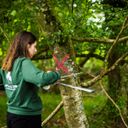

Step 1
A sustainable forest management plan is drawn up by our foresters with the help of an expert and submitted to the CRPF (Centre régional de la Propriété forestière) for validation. We develop these plans in close collaboration with regional bodies such as local town councils, environmental authorities, agencies, and so on, while also considering the input of local residents, farmers, and stakeholders, to ensure the forest meets ecological and community needs.
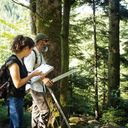
Step 2
The selected tree species are either planted in case of artificial regeneration or favoured and managed in case of natural regeneration. This approach helps overcome a widespread issue in European forests, where centuries of human intervention have resulted in low diversity. href=”https://environment.ec.europa.eu/news/green-deal-new-guidelines-sustainable-forest-management-and-payment-schemes-forest-ecosystem-2023-07-27_en”> With 75% of forests being even-aged, and ⅓ dominated by only a single species, their resilience to threats such as fires, pest outbreaks, and carbon sequestration is significantly reduced.
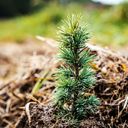
Step 3
We carry out annual maintenance around young saplings to prevent competing vegetation from hindering their growth. In more mature forests, we carry out partitioning (selective) cuts to improve light and space for other trees, helping the forest stay healthy and diverse. This method follows Closer to Nature and PRO SILVA principles, which aim to create resilient, mixed-species forests that support biodiversity, adapt to climate change, and deliver long-term benefits, fully in line with the EU Forest Strategy and Green Deal objectives.
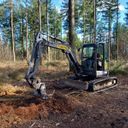
Step 4
Thinnings are carried out in accordance with the specifications of the sustainable management plan, to encourage the growth of future stems. When thinning is done properly, it can enhance biodiversity by increasing the availability of light, water, and nutrients to remaining trees, encouraging the growth of diverse understory vegetation. It also maintains structural diversity through selective tree removal, supporting a range of tree sizes and ages that are vital for forest health and ecosystem function.
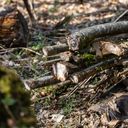
Step 5
Mature trees are harvested and sold as timber. Their owners receive the profit. In an irregular high-forest system, selective harvesting maintains continuous ground cover, ensuring the soil is never left bare. By maintaining trees of different ages and sizes throughout the forest, the soil remains protected, supporting continuous natural regeneration.
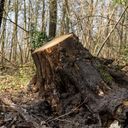
Clear cuts have three major consequences.
Soil erosion
Soil contained and enriched by deep roots is suddenly exposed. Without protective litter and a supply of nutrients, it loses strength. Water starts to run off the soil, which is no longer aerated by roots and microorganisms. The erosion caused makes any form of natural regeneration or planting very difficult. Pioneer tree species may be possible, but they are the least interesting for biodiversity and producing wood. It takes a long time to recover a rich ecosystem after clearcutting.
A change in climate
Soil is one of the planet's main carbon reservoirs, along with oceans and forests. When soil is exposed by clearcutting, carbon previously stored in organic form is released into the atmosphere as CO2. That’s just one reason the process is a major contributor to greenhouse gas emissions.
Weakened biodiversity
Clearcutting is a brutal and devastating disruption of a forest’s ecosystem. For its birds, insects, mammals, fungi and plants, living without shelter and food quickly becomes impossible. They all need a stable environment to thrive and maintain that strong biodiversity our planet desperately needs.
We avoid the use of any pesticide or chemical product. Our saplings are protected:

We build fences that are not intended to remain longer than the few years necessary for the trees to be strong enough to resist wild game attacks. These fences surround the entire plantation, but they can also be individual protections, installed around each shrub.

We develop dead or dry hedges – dead roots and branches that are long and thick enough to create an effective shelter or barrier. They often come from thinning or branches that fall by natural pruning.

We use trico, a natural emulsified solution of sheep's fat that we put on the trees. The grease repels deer that would happily graze on our saplings.
We do not use chemicals, which means some saplings may die within a year of being planted. That's why we always schedule one or two replanting phases to replace those saplings that do not survive.
Let's work together to help forests adapt to climate change by making them more resilient and protecting biodiversity. Let's act through sustainable forest management!
On a global scale, forests store about 8 billion tons of CO2 annually. However, our global emissions were about 40.6 billion tons of CO2 in 2022, an increase of one percent compared to 2021. While forests act as carbon sinks, this alone cannot stop climate change. We must therefore combine sustainable forest management with a drastic reduction in our emissions.
80% of terrestrial biodiversity is housed in forests. Yet, according to the French Biodiversity Office, only 18% of forest ecosystems were well preserved between 2013 and 2018. Even if the number of tree species is increasing, there are still black spots in France: more than half of forest plants, 17% of forest birds and 7% of forest mammals are threatened. In addition, some forest habitats (alluvial forests, peat bogs, etc.) are in a poor state of preservation. The sustainable management of forests, with the aim of preserving biodiversity, is therefore a global and national issue.
The commercial value of the total wood harvest of the French forests is estimated at nearly 3 billion euros. The forest also produces a multitude of other goods that represent several million euros of annual sales: mushrooms, chestnuts, honey, aromatic plants, fodder, cork... The production of timber, industrial wood and energy wood is essential to the ecological transition. Our sustainable forest management is part of this dynamic that reconciles economy and ecology.
The French forest covers about one third of the French territory (17 million hectares). It is a reservoir of diverse species but also a place of reception of the public. Forests are part of our living heritage. They shape our landscapes and our history. Populations world-wide have a very strong link with their forests. Forests are also a place to raise awareness of the current climate change. This is why we are setting up educational trails in some of our forests.